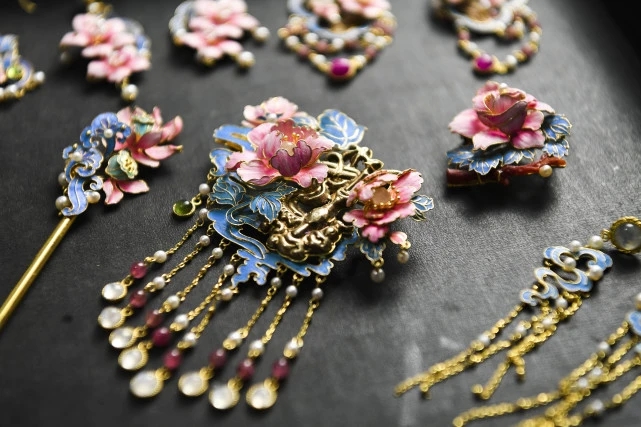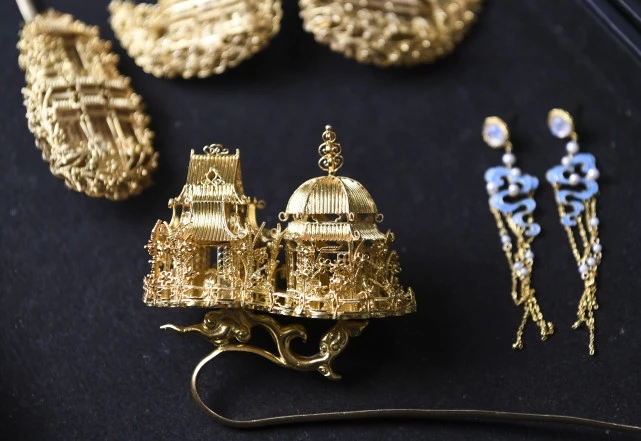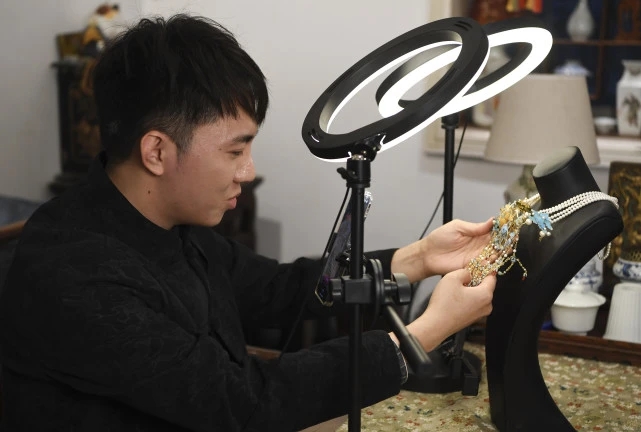Young inheritor passes down traditional filigree inlay craft after pursuing his dream job
With most craftsmen engaging in the filigree inlay craft being elderly people, Gu Guoqiang, a man born in the 1990s in southwest China’s Chongqing Municipality, stands out among his peers after devoting himself to carrying forward the craft.

Gu Guoqiang prepares material for making filigree inlay artworks. (Xinhua/Wang Quanchao)
With gold or silver as raw material, filigree inlay craftsmen apply complex techniques such as knitting and welding to shape metal wires into various forms. Then they create fluted patterns on the main body of the artwork with techniques such as hollowing and cutting before inserting gems. Once a royal craft in China, the traditional filigree inlay techniques were listed as a national intangible cultural heritage item in 2008.
Gu majored in porcelain in college, and after graduating from college he went to Beijing to learn about the restoration techniques used for cultural relics at the Palace Museum for half a year. When he first encountered the filigree inlay craft, Gu was deeply impressed by the exquisite techniques applied in the creation of the artworks.

Gu Guoqiang shows a filigree inlay artwork. (Xinhua/Wang Quanchao)
Gu also found that most craftsmen engaged in the craft were elderly people. “I think people of my generation should pass down the craft so that it won’t become something our children can appreciate only at museums,” Gu expressed. He then returned to Chongqing and became an apprentice of Li Changyi, a filigree inlay craft inheritor in the city who was already 70 years old at the time.
Though the filigree inlay craft includes complex techniques and the skills are not easy for one to master, Gu has never felt bored or impatient during the learning process, instead he became quite obsessed with the craft. He also believes that the artworks can carry rich cultural meanings.
“I’ve also devoted great efforts to improving the design of the artworks, trying to ensure that each piece of artwork conveys a theme and all the elements used to create the artwork are conducive to expressing the specific theme,” remarked Gu.
Five years ago, Gu opened a filigree inlay workshop. Now, the 15-member team from the workshop is able to produce about 1,000 pieces of filigree inlay works in a year. Their flagship artwork is one that was created by using more than 1-million-yuan worth of raw materials, and it is now used for display purposes only. One of the team’s videos that shows Gu repairing an old bridal crown was watched more than 7.4 million times on the short-video sharing platform Kuaishou, revealing people’s growing interest in the traditional craft.

Filigree inlay artworks Gu Guoqiang made. (Xinhua/Wang Quanchao)
When he first got engaged in the business, Gu’s family members and relatives didn’t understand why he chose it as a career due to their lack of understanding towards the craft. The young man also encountered various difficulties when attempting to sell the artworks at the beginning. Thanks to the help he has received from experienced industry insiders, Gu’s artworks gradually gained popularity among various consumers. After finding out that Gu had built a prosperous business, his friends and relatives eventually threw their support behind his craft.
When some young consumers expressed that the filigree inlay artworks created by Gu are a little expensive despite their exquisite craftsmanship, Gu explained that the artworks are all handmade, with each piece of artwork taking a craftsman between 10 to more than 20 days to complete.

Filigree inlay artworks Gu Guoqiang made. (Xinhua/Wang Quanchao)
Gu said he will continue to strengthen publicity for the craft so that young people can know more about the techniques and further enhance their confidence in traditional Chinese culture. He also expressed the hope that young people can join his efforts in inheriting the craft so as to inject new vitality into it.

Gu Guoqiang introduces filigree inlay artworks in a livestreaming session. (Xinhua/Wang Quanchao)
Photos
Related Stories
- Public artworks form important cultural heritage for the Beijing Winter Olympic Games
- World-renowned artworks shine at 4th CIIE
- 88-year-old grandmother in Hangzhou makes artworks using fish bones
- Photographer transforms famous locations into amazing artwork using paper cut-out props
- Tibetan Buddhism art exhibition held in N China
- Amazing pictures show artwork made from lights transforming the outback around Ayers Rock
Copyright © 2022 People's Daily Online. All Rights Reserved.










